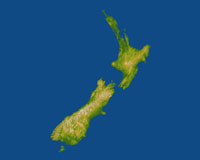| . |  |
. |
Washington DC (SPX) Jul 29, 2009 A new analysis of jade found along the Motagua fault that bisects Guatemala is underscoring the fact that this region has a more complex geologic history than previously thought. Because jade and other associated metamorphic rocks are found on both sides of the fault, and because the jade to the north is younger by about 60 million years, a team of geologists posits in a new research paper that the North American and Caribbean plates have done more than simply slide past each other: they have collided. Twice. "Now we understand what has happened in Guatemala, geologically," says one of the authors, Hannes Brueckner, Professor of Geology at Queens College, City University of New York. "Our new research is filling in information about plate tectonics for an area of the world that needed sorting." Jade is a cultural term for two rare metamorphic rocks known as jadeitite (as discussed in the current research) and nephrite that are both extremely tough and have been used as tools and talismans throughout the world. The jadeitite (or jadeite jade) is a sort of scar tissue from some collisions between Earth's plates. As ocean crust is pushed under another block, or subducted, pressure increases with only modest rise in temperature, squeezing and drying the rocks without melting them. Jade precipitates from fluids flowing up the subduction channel and into the chilled, overlying mantle that becomes serpentinite. The serpentinite assemblage, which includes jade and has a relatively low density, can be uplifted during subsequent continental collisions and extruded along the band of the collision boundary, such as those found in the Alps, California, Iran, Russia, and other parts of the world. The Motagua fault is one of three subparallel left-lateral strike-slip faults (with horizontal motion) in Guatemala and forms the boundary between the North American and Caribbean tectonic plates. In an earlier paper, the team of authors found evidence of two different collisions by dating mica found in collisional rocks (including jade) from the North American side of the fault to about 70 million years ago and from the southern side (or the Caribbean plate) to between 120 and 130 million years ago. But mica dates can be "reset" by subsequent heating. Now, the authors have turned to eclogite, a metamorphic rock that forms from ocean floor basalt in the subduction channel. Eclogite dates are rarely reset, and the authors found that eclogite from both sides of the Motagua dates to roughly 130 million years old. The disparate dating of rocks along the Motagua can be explained by the following scenario: a collision 130 million years ago created a serpentinite belt that was subsequently sliced into segments. Then, after plate movement changed direction about 100 million years ago, a second collision between one of these slices and the North American plate reset the mica clocks in jadeitite found on the northern side of the fault to 70 million years. Finally, plate motion in the last 70 million years juxtaposed the southern serpentinites with the northern serpentinites, which explains why there are collisional remnants on both sides of the Motagua. "All serpentinites along the fault line formed at the same time, but the northern assemblage was re-metamorphosed at about 70 million year ago. There are two collision events recorded in the rocks observed today, one event on the southern side and two on the northern," explains author George Harlow, Curator in the Division of Earth and Planetary Sciences at the American Museum of Natural History. "Motion between plates is usually not a single motion-it is a series of motions.
Share This Article With Planet Earth
Related Links American Museum of Natural History Tectonic Science and News
 Massive quake moves New Zealand closer to Australia
Massive quake moves New Zealand closer to AustraliaWellington (AFP) July 22, 2009 A massive 7.8 magnitude earthquake last week has moved the south of New Zealand closer to Australia, scientists said Wednesday. With the countries separated by the 2,250-kilometre-wide (1,400-mile-wide) Tasman Sea, the 30 centimetre (12 inch) closing of the gap in New Zealand's southwest won't make much difference. But earthquake scientist Ken Gledhill of GNS Science said the shift illus ... read more |
|
| The content herein, unless otherwise known to be public domain, are Copyright 1995-2009 - SpaceDaily. AFP and UPI Wire Stories are copyright Agence France-Presse and United Press International. ESA Portal Reports are copyright European Space Agency. All NASA sourced material is public domain. Additional copyrights may apply in whole or part to other bona fide parties. Advertising does not imply endorsement,agreement or approval of any opinions, statements or information provided by SpaceDaily on any Web page published or hosted by SpaceDaily. Privacy Statement |